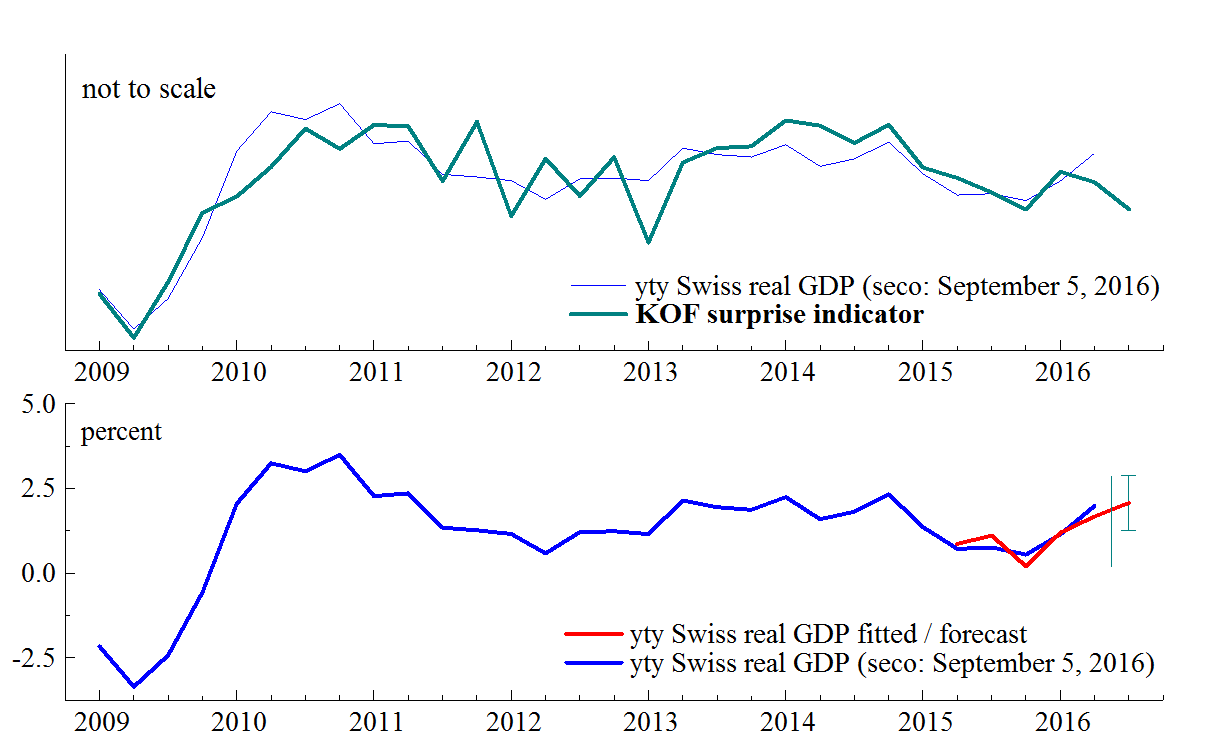GDP forecast based on semantic business cycle identification - release: 2016-11-16
Date |
Year-to-year growth (%) of Swiss real gross domestic product (GDP) |
||||
|---|---|---|---|---|---|
fitted / forecast |
standard error |
seco estimates* |
|||
2016(1) |
1.19 |
- |
0.7 |
1.14 |
|
| 2016(2) | - |
- |
1.99 |
||
| 2016(3) | 0.40 |
- |
- |
||
Sources: Own calculations, forecast for 2016(3), fitted values otherwise, *seco releases (left: September 5, 2016, right: March 8, 2016).
Sample: 2000 (2) - 2016 (2), Forecast: 2016 (3)
Note: Forecasts obtained by best nowcasting model.
Forecast update. The third quarter of this year witnessed the second consecutive decline of the «KOF surprise indicator» for measuring Swiss economic dynamics to -0.044 (down from -0.036). This new level is comparable to the end of last year's reading and indicates the approach of the maximum rate of expansion of the Swiss economy.
For the time being the new reading of the «KOF surprise indicator» implies an even stronger expansion of the Swiss economy year-on-year with real GDP growth now estimated to reach 2.07 percent in 2016, second quarter.
Though based on the «KOF surprise indicator» this new estimate comes on the back of severely revised quarterly GDP figures (see table 1). This latest official release shows a rather strong performance of the Swiss economy but simultaneously raises several concerns with respect to the actual information offered by Swiss GDP data:
- GDP growth in 2015 (+0.8 percent) was driven by transit trade's contribution to the tune of half the total rate of expansion. Transit trade has hardly any visible impact on employment and its real value added depends (inversely) on import price indices, especially crude oil prices.
- The latest revisions of quarterly GDP growth between 2014 and 2016q2 exhibit a root mean squared error of 0.6 and a mean absolute error of 0.18 percentage points respectively in addition to a puzzling re-ordering of the various sectors' contribution to GDP growth.
- National and international unemployment statistics consistently diverge with the former systematically underreporting (especially long-term) unemployment.
| NOTES | |
| Previous update | |
| Standard error of regression* | 0.64 |
| Literature | |
| Business cycle data | download |
| History | |
| Complete release history | |
| First release | |
| Next release | 2016-02-15 |
